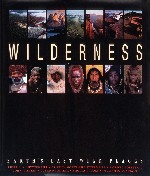
|
 |
Our Criteria for Wilderness
We recognize that achieving a globally agreed-upon definition for wilderness is not easy, and may not even be entirely necessary. Nonetheless, we attempt here to define what we consider wilderness from the perspective of an international conservation organization concerned with the maintenance of biodiversity and ensuring that intact natural systems continue to provide benefits to global society.
We believe that wilderness is part of an ecological continuum determined by the intensity of human impacts. These impacts have changed historically. In the Americas, everything was wilderness 50,000 years ago in the sense that people were entirely absent. Humans eventually reduced substantial parts of the Americas to managed systems in which humans were the primary ecological architects, for example, the intensively farmed and engineered earthworks in the Andes and Mesoamerica that flourished before the conquest. Following the conquest, decimation of these cultures returned many of the areas to a more wilderness-like condition in which humans played a less dominant ecological role. In the absence of people, the fauna and flora coevolve and adapt at the slow pace of evolutionary change. Under some preagricultural, preindustrial conditions, humans are part of this gradual coevolutionary process. Human cultural evolution, however, has largely outstripped the pace of normal evolutionary biomass to grow exponentially to a collective total of some 600 billion tons of human protoplasm. It is the relative freedom from the transformative ecological impacts of this mass of humanity that ecologically defines "wilderness."
We recognize the enormous value of the many legal definitions that exist, and are fully in agreement with and supportive of the IUCN definition and the various groundbreaking pieces of American and other national and state legislation. However, we also realize that all this legislation refers to wilderness in the context of protected areas like parks and reserves, which forces upon it a scale that we believe is several orders of magnitude less than what must be achieved if wilderness areas are to play the role that we envision for them.
To be sure, we acknowledge the enormous importance of protected areas and indeed have them as one of our three principal categories of biodiversity conservation outcomes (along with preventing species extinctions and creating landscape-level conservation corridors, Conservation International 2002). Furthermore, we recognize the great opportunities that exist to create more protected areas in wilderness and are fully engaged in this process through our Global Conservation Fund (GCF, see below). Indeed, given that the results of this study indicate that globally only 7.4% of the wilderness areas defined by this study are currently in strictly-protected parks and reserves (IUCN Categories I-IV), we believe that there needs to be an enormous global push to create many more protected areas in these critically-important regions. However, unlike the hotspots, where virtually all that will remain will perforce be in strictly-managed parks and reserves, we believe that the maintenance of wilderness must go beyond parks and reserves. To take an extreme example, imagine if we succeeded in protecting 50% of Antarctica in parks and reserves (a percentage that exceeds that of any country on Earth), but allowed the remaining 50% to degrade. The increase in sea level worldwide would have disastrous consequences. The same is true of Amazonia, where roughly a third is already under some formal designation. What if the remainder of this region, which generates at least 50% of its own rainfall, where severely degraded, burned, or clearcut—as has already happened in the Atlantic forest region of Brazil? And what about the Boreal Forests, the Arctic Tundra, and many other immense wilderness areas that play a critical role in Earth's delicate ecological balance? Societal recognition of the importance of wilderness simply must be more encompassing, and must truly lead us to a major shift in the way in which we value the natural world. It must also begin to recognize that wilderness areas, especially the largest and most intact, play an immense yet still poorly-measured, role in maintaining the ecological health and integrity of our planet.
As a result, our criteria for wilderness are at a broad, biome level and take into consideration size, intactness of natural systems, human population density, and biodiversity. Although these are difficult to establish for such a widely-interpreted, much-used term (in contrast to hotspots, which was a new term with no legal history), we believe that some rough quantitative criteria are necessary and therefore attempt to establish some here.
Wilderness Criteria - Size
First of all, a wilderness area needs to be a distinct biogeographic unit, or a series of units (e.g., ecoregions) within a biome type that share certain biological features. Once the biogeographic unit is defined, we believe that a wilderness area needs to be large and intact, a distinct difference from hotspots, most of which are small and highly-fragmented. Consequently, our initial cutoff point for wilderness status is much higher than any that exist in the protected-area focused legal definitions, i.e., a minimum of 10,000 km², or 1 million ha. This is larger than what remains in many hotspots and much larger than anything that exists in current wilderness legislation. For comparative purposes, this is an area a little smaller than the American state of Connecticut.
Wilderness Criteria - Intactness
One of the principal criteria for hotspots was percent of natural vegetation remaining intact. In order to qualify for hotspot status, an area had to have lost 70% or more of its original natural vegetation, leaving only 30% intact. For wilderness areas, we are proposing the opposite, that to qualify as a wilderness area, a region would have to be 70% or more intact as determined by remaining natural vegetation—meaning that no more than 30% of the region could be destroyed or significantly degraded by human activities.
We also believe that it is critical that these areas still maintain intact faunal assemblages of large mammals and birds, especially large, wide-ranging predators (large cats, bears), large raptors like eagles, large herbivores, large frugivorous primates, and other key species that are the first to disappear in the face of human pressure. If these are absent, it is usually indicative of heavy hunting pressure that has already drastically modified what would otherwise be an intact system.
Wilderness Criteria - Human Population Density
In terms of human population density, we suggest a cutoff point of ca. 5 inhabitants/km² for the region as a whole, once urban areas have been subtracted from the total. In some cases, the human population will be much lower, well under 1 inhabitant/km². However, a number of other important areas have significant indigenous populations widely dispersed in rural areas (e.g., Congo, New Guinea). Though large portions of such regions are still intact, population density is somewhat higher, and averages around 5 inhabitants/km².
Hotspots, in contrast, have an average human population density of 74 inhabitants/km² and a range of 7 to 342 inhabitants/km². Only one hotspot, South Africa's Succulent Karoo, has a population density (3 inhabitants/km²) that would fall below the wilderness cutoff (Cincotta and Engelman 2000).
Wilderness Criteria - Biodiversity
Last but not least, we included a biodiversity criterion to determine which wilderness areas make the greatness contribution to global biodiversity conservation. This is not a criterion for inclusion as a wilderness in itself, but rather one that distinguishes between wilderness areas that are important because of their size and intactness alone and those that are also rich in biodiversity. To do this, we use a criterion very similar to that employed in both the megadiversity and hotspots analyses—vascular plant endemism—in recognition of the critical role of plants in the survival of all other terrestrial life-forms (Mittermeier et al. 1997; Mittermeier et al. 1999; Myers et al. 2000). The cutoff point chosen here is the same used in the hotspots analysis: 0.5% of global vascular plant diversity (300,000 species) endemic to the region as defined, or 1,500 endemic vascular plant species.
However, it is important to note that the biodiversity criterion was applied in a second layer of analysis after the region in question had already made the wilderness list based on size, intactness, and low human population density. This is a significant difference from the hotspots analysis, in which the biodiversity criterion (›1,500 endemic vascular plants) was the first consideration. This difference recognizes the multiple values of wilderness, and their great importance in other aspects of global environmental health and integrity.
|





